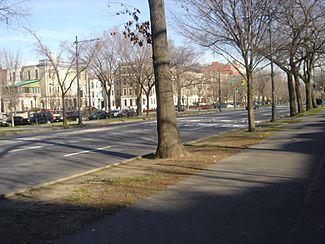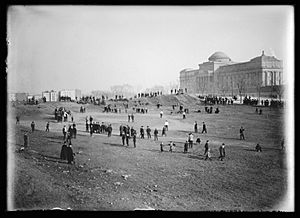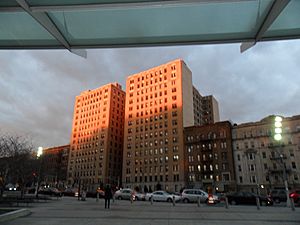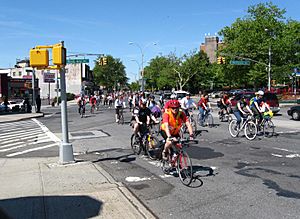Eastern Parkway facts for kids

Near New York Avenue in Crown Heights
|
|
| Former name(s) | Sackett Street |
|---|---|
| Maintained by | NYCDOT |
| Length | 4.2 mi (6.8 km) |
| Width | 70 to 200 feet (21 to 61 m) |
| Restrictions | No commercial vehicles |
| Location | Brooklyn, New York |
| Postal code | 11207, 11213, 11216, 11225, 11233, 11238 |
| West end | Grand Army Plaza in Prospect Heights |
| East end | Bushwick Avenue in Bushwick |
|
Eastern Parkway
|
|
| Location | Brooklyn, New York City |
| Area | 63.69 acres (25.77 ha) |
| Built | 1870–1874 |
| Architect | Frederick Law Olmsted; Calvert Vaux |
| NRHP reference No. | 83001689 |
| Significant dates | |
| Added to NRHP | September 26, 1983 |
Eastern Parkway is a famous road in Brooklyn, New York City. It was designed by Frederick Law Olmsted and Calvert Vaux. These two also designed Central Park and Prospect Park.
Eastern Parkway was built between 1870 and 1874. It was the world's first "parkway." A parkway is a special road designed for cars and recreation, often with green spaces. When it was built, it reached the eastern edge of Brooklyn, which is how it got its name.
The parkway starts at Grand Army Plaza, which is the main entrance to Prospect Park. It stretches east to Ralph Avenue. This part of the road has beautiful landscaped areas in the middle. East of Ralph Avenue, the road continues but becomes narrower. This part is called the Eastern Parkway Extension. It ends near Evergreen Cemetery at Bushwick Avenue.
Eastern Parkway was meant to be the center of a neighborhood with fancy homes. Over time, many different types of buildings were built here. These included single-family homes, large mansions, and apartment buildings. The subway's Eastern Parkway Line opened in 1920. This helped more people move to the area. The western part of Eastern Parkway is now a special New York City landmark. It is also listed on the National Register of Historic Places.
Contents
What Does Eastern Parkway Look Like?
Eastern Parkway is a wide road with several lanes. It has special lanes called "service roads" on the sides. These are separated from the main road by grassy areas called medians. The parkway passes by many important places. These include the Brooklyn Central Library, the Brooklyn Museum, and the Brooklyn Botanic Garden. These are all on the south side of the parkway.
The section between Washington and Ralph Avenues has service roads on both sides. It goes past places like the Chabad-Lubavitch world headquarters. It also passes the Jewish Children's Museum in Crown Heights.
East of Ralph Avenue, Eastern Parkway becomes the Eastern Parkway Extension. This part is narrower. It curves northeast and connects to the Jackie Robinson Parkway. Originally, the parkway continued further east along what is now Pitkin Avenue.
How the Parkway Was Designed
Eastern Parkway was the first parkway built just for personal cars and fun, not for big trucks. Frederick Law Olmsted called a parkway "a shaded green ribbon." It was designed to be beautiful. The main part of the parkway is about 200 feet (61 m) wide. It has two service roads, two medians, and a main road.
The medians are green spaces with trees, benches, and paths for walking. These paths have special hexagonal asphalt tiles. The Eastern Parkway Extension is narrower, about 70 feet (21 m) wide. It has a smaller median that separates traffic.
When it was first built, about 1,100 trees were planted along the parkway. Most of these were elm and maple trees. Today, you can find about 25 different kinds of trees. Many trees have plaques to remember soldiers from World War I.
Bike and Walking Paths
The median on the south side of the parkway has a bike path. This path is part of the Brooklyn-Queens Greenway. It connects to other bike paths in Prospect Park and Forest Park. The bike path is separated from the walking path by a special "rumble strip." The median on the north side is only for people walking.
Traffic and Safety on the Parkway
On the main part of Eastern Parkway, between Grand Army Plaza and Ralph Avenue, large commercial vehicles are not allowed. The service roads are mostly for local traffic. However, trucks are allowed on the Eastern Parkway Extension.
The main road of Eastern Parkway has traffic lights at all intersections. But some service roads might only have stop signs. This can make it tricky for drivers and people walking. Because the parkway is so wide and some intersections are confusing, it can be dangerous. The city is working to make it safer. They plan to add more traffic lights to all service roads.
History of Eastern Parkway
Eastern Parkway sits on a high ridge called the Harbor Hill Moraine. This ridge was formed by a glacier about 17,000 years ago. Mount Prospect, a hill near the parkway, is one of the tallest spots in Brooklyn.
During the American Revolutionary War, this area was important. It was a site of the Battle of Long Island. American soldiers fought here to hold back the British. This allowed George Washington's army to escape.
Planning and Building the Parkway
Frederick Law Olmsted and Calvert Vaux first suggested building Eastern Parkway in 1866. They also suggested Ocean Parkway. They wanted these roads to connect Prospect Park to other parts of Brooklyn. Their ideas came from famous boulevards in Europe, like those in Berlin and Paris. But Eastern and Ocean Parkways were designed to be even better. They would have service roads separated by tree-lined medians.
Building the parkway was hard because it was on a high, rocky ridge. Workers had to dig up a lot of stone for the road. By 1874, Eastern Parkway was finished. The main road was paved with macadam, and the service roads used stone blocks.
Later Years and Development

The city hoped that Eastern Parkway would encourage fancy homes to be built. The area became known as "Doctor's Row" because many doctors and professionals moved there. The Eastern Parkway Extension was built in the late 1890s. It went northeast towards Cemetery of the Evergreens.
In the early 1900s, the New York City Subway built lines under Brooklyn. The IRT Eastern Parkway Line opened in 1920. It ran under Eastern Parkway. This brought many new residents, including Jewish and African-American families. They moved into new apartment buildings along the parkway.
In 1978, Eastern Parkway was named a scenic landmark by New York City. It was also added to the National Register of Historic Places in 1983. In the late 1980s, the parkway was renovated. New pipes, roads, sidewalks, and bike lanes were added. Trees were replanted to make it even greener.
Buildings and Attractions

Eastern Parkway has many different types of buildings. You can see rowhouses, apartment buildings, and large mansions. Some of the most famous buildings include the Beaux-Arts Brooklyn Museum and the neoclassical Brooklyn Public Library's central branch.
Many important places are along Eastern Parkway. These include:
- The Brooklyn Museum
- The Brooklyn Public Library's central branch
- The Brooklyn Botanic Garden
- The Lubavitch world headquarters at 770 Eastern Parkway
- The Jewish Children's Museum
The parkway also passes by several parks. These include Mount Prospect Park, Callahan, and Kelly Playground. Many schools and colleges are also nearby, like Medgar Evers College.
Eastern Parkway is a dividing line for communities in Crown Heights. It separates the black community to the north from the Jewish community to the south. This separation became very clear during community tensions in 1991.
Events on the Parkway
Eastern Parkway is famous for the West Indian Day Parade. This is a big, colorful celebration that happens every year around Labor Day. Millions of people come to watch and participate in the parade. It has been held on Eastern Parkway since the late 1960s.
Getting Around Eastern Parkway
The New York City Subway's IRT Eastern Parkway Line runs right under the parkway. There are several subway stations along the route:
- Eastern Parkway–Brooklyn Museum
- Franklin Avenue
- Nostrand Avenue
- Kingston Avenue
- Crown Heights–Utica Avenue
The Broadway Junction station is at the very eastern end of the Eastern Parkway Extension. Some city buses, like the B14 and B17, also travel along parts of the parkway.
See also
 In Spanish: Avenida Eastern Parkway para niños
In Spanish: Avenida Eastern Parkway para niños



